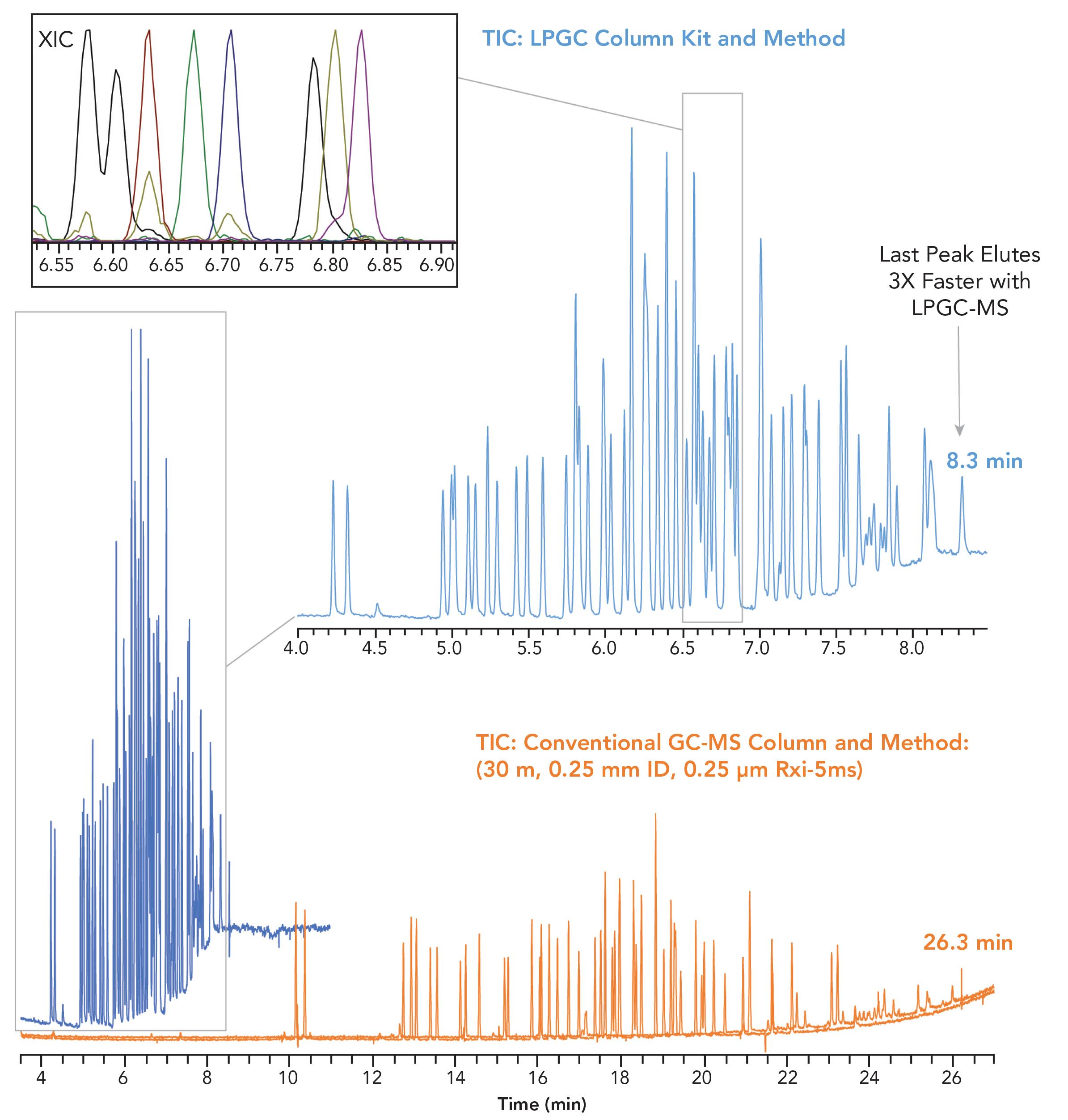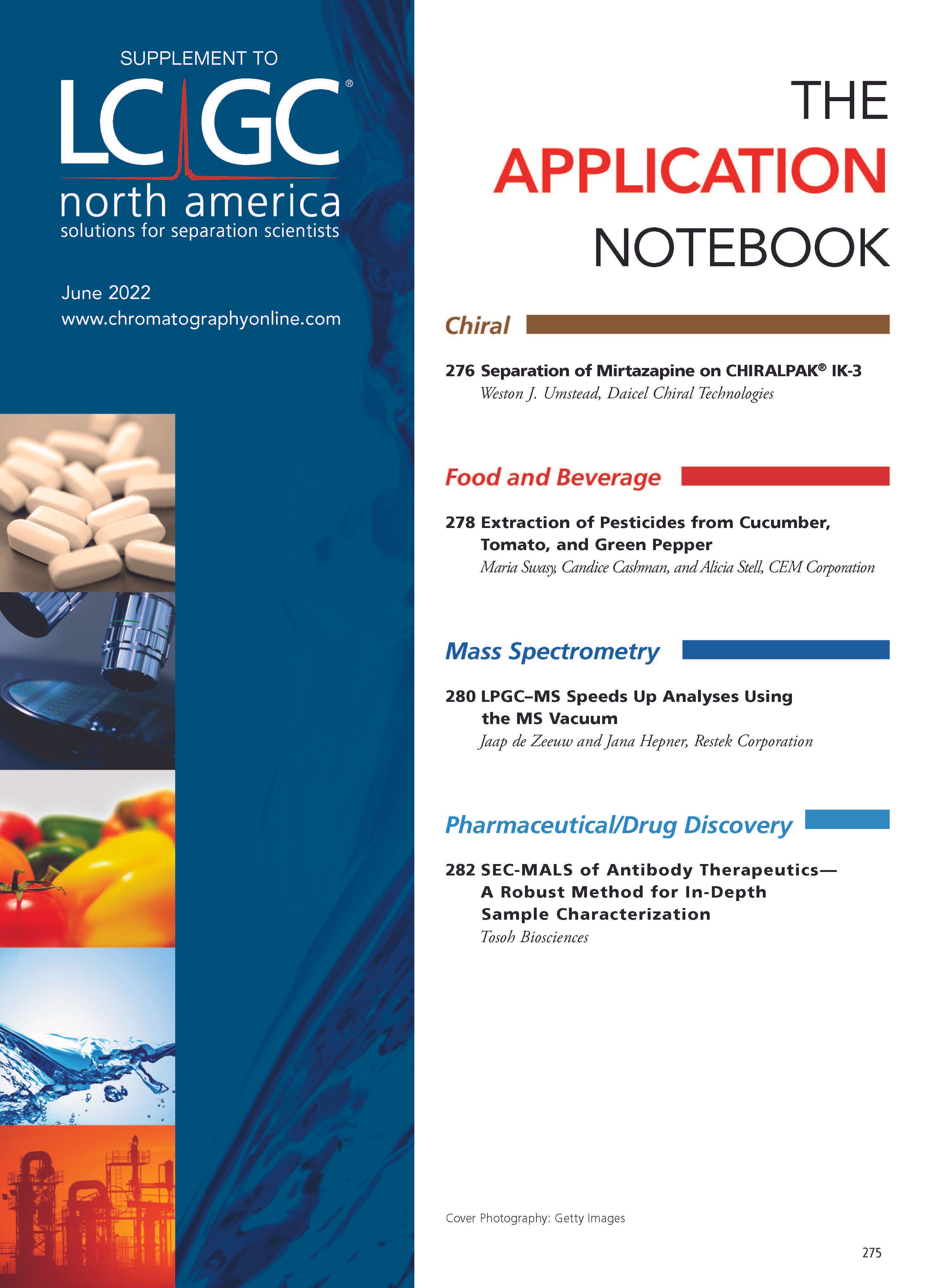LPGC–MS Speeds Up Analyses Using the MS Vacuum
• Three times faster analysis of multiresidue pesticides in foods.
• Simple setup using a factory-coupled, leak-free kit.
• Ideal for fast GC–MS and GC–MS/MS methods.
Using a mass spectrometer as a gas chromatography (GC) detector has many advantages for compound identification and quantification, but there is another less-known benefit: speeding up analyses by using the mass spectrometry (MS) vacuum to lower pressure within the column. This technique, also known as “vacuum‑outlet GC” or “low-pressure GC–MS” (LPGC–MS), can provide significant gains for fast GC–MS (1). For example, Figure 1 demonstrates that LPGC–MS using an LPGC column kit is three times faster than a conventional GC–MS analysis of multiresidue pesticides in food. Historically, the difficulty of making a manual leak-free connection has been a barrier to LPGC adoption but using a factory-connected kit makes leak-free installation simple and allows the speed gains of LPGC to be reliably achieved.
Figure 1: Compared to a conventional setup, this LPGC–MS analysis of pesticides in food is 3× faster, even though a lower efficiency column is used. Sensitivity may be higher because the increased linear velocity creates taller, narrower peaks. Note that even closely eluted peaks can still usually be resolved by MS.

There are several options for fast GC–MS, so what makes LPGC–MS advantageous? For MS work, a 30 m × 0.25 mm column is usually used. This format generates about 120,000 theoretical plates, has optimum carrier gas flow rates within the MS vacuum pump capabilities, and can maintain positive inlet pressure, despite the vacuum at the end of the column. Here is a comparison of several common fast GC strategies to the LPGC–MS approach used in Figure 1:
1. A Shorter, Narrower Column
A 10 m × 0.10 mm column has similar efficiency (plate number)
and resolving power to a 30 m × 0.25 mm column. But this format has very low column capacity, so low concentrations or injection volumes must be used to avoid peak distortion.
2. A 30 m × 0.25 mm Column Run at a Higher Flow
Increasing the flow rate is the easiest way to reduce analysis time.
But, to get the 3× faster analysis shown in Figure 1, a flow of approximately 12 mL/min is needed. This requires an inlet pressure of approximately 63 psi, which is problematic for injection, MS data acquisition rate, and MS pump capacity.
3. A 10 m × 0.25 mm Column Run at Optimal Carrier Gas Flow Rate
A 3× shorter column has about 40,000 theoretical plates and should speed up analysis by 3–4×, but the inlet pressure required for this scenario is about 0.35 psi, which is very difficult to control. At such pressures, split injection is a challenge, column trimming is barely possible because it affects pressure, and extremely narrow peak widths make MS data acquisition challenging.
4. An LPGC Column Kit
An LPGC column kit consists of a 15 m × 0.53 mm analytical column that is factory coupled to a 5 m × 0.18 mm restrictor column. This configuration produces about 30,000 theoretical plates and can be operated at standard flow rates of about 2 mL/min. Optimal carrier gas linear velocities are very high because of the vacuum inside the 0.53 mm i.d. analytical column. This results in very short analysis times (typically 3× faster compared to a 30 m × 0.25 mm column). Peak widths are 1.5–2 s, which is broad enough for MS data acquisition. In addition, the 0.53 mm column has high capacity due to the 1 µm Rtx-5ms film.
How It Works
LPGC–MS speeds up analysis by using the MS vacuum, along with a specially designed column setup, to lower pressure inside the entire column. As Figure 2 illustrates, a 0.53 mm analytical column is inserted directly into the MS system. A flow restrictor is used on the GC inlet side; this allows low pressure to be maintained throughout the 0.53 mm analytical column. The reason an LPGC column kit makes this technique easier is because it provides a robust, zero-dead-volume, factory coupling of the necessary restrictor column and the recommended analytical column (which also includes an integrated transfer line). The LPGC column kit has been specifically designed to install easily, and each one is tested to ensure leak-free performance, meaning the setup for LPGC–MS is now essentially as easy as changing a column.
Figure 2: How low-pressure GC–MS with an LPGC column kit works.

Implementation Considerations
Although the LPGC column kit makes the technique’s physical setup much simpler and more reliable than manual connections, some method development time is still required when translating a conventional method. This includes setting the column dimensions (restrictor column only) in the GC software and adjusting the oven ramp and flow rate as necessary. Online method translation calculators should not be used because they do not allow you to directly calculate new method conditions for low-pressure GC. Although some method development work is necessary when implementing LPGC, the significant increase in sample throughput makes it a worthwhile investment.
Reference
S.J. Lehotay, J. de Zeeuw, Y. Sapozhnikova, N. Michlig, J. Rousova Hepner, and J.D. Konschnik, LCGC North Am.38, 457–466 (2020).

Restek Corporation
110 Benner Circle, Bellefonte, Pennsylvania 16823, USA
Tel. 1 (814) 353 1300
Website: www.restek.com
University of Rouen-Normandy Scientists Explore Eco-Friendly Sampling Approach for GC-HRMS
April 17th 2025Root exudates—substances secreted by living plant roots—are challenging to sample, as they are typically extracted using artificial devices and can vary widely in both quantity and composition across plant species.
Common Challenges in Nitrosamine Analysis: An LCGC International Peer Exchange
April 15th 2025A recent roundtable discussion featuring Aloka Srinivasan of Raaha, Mayank Bhanti of the United States Pharmacopeia (USP), and Amber Burch of Purisys discussed the challenges surrounding nitrosamine analysis in pharmaceuticals.








